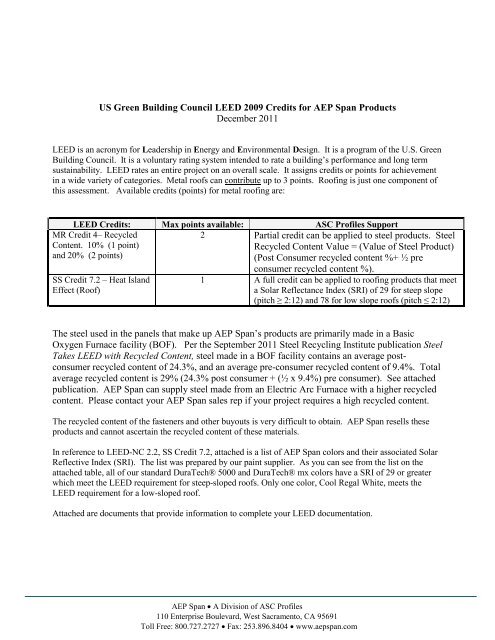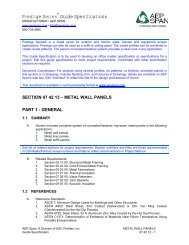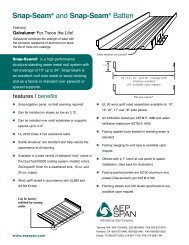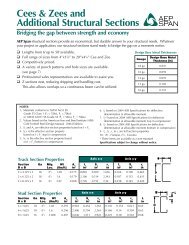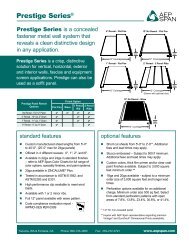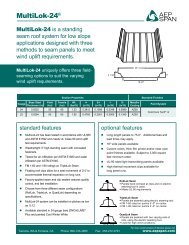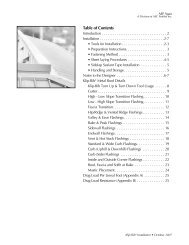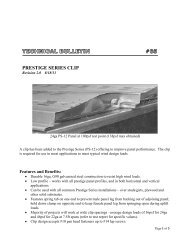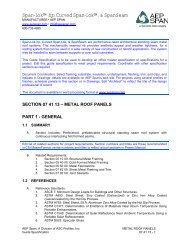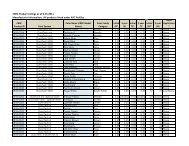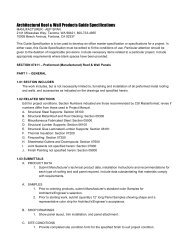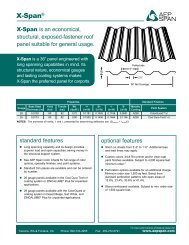AEP LEED 2009 Documentation - AEP Span
AEP LEED 2009 Documentation - AEP Span
AEP LEED 2009 Documentation - AEP Span
Create successful ePaper yourself
Turn your PDF publications into a flip-book with our unique Google optimized e-Paper software.
US Green Building Council <strong>LEED</strong> <strong>2009</strong> Credits for <strong>AEP</strong> <strong>Span</strong> Products<br />
December 2011<br />
<strong>LEED</strong> is an acronym for Leadership in Energy and Environmental Design. It is a program of the U.S. Green<br />
Building Council. It is a voluntary rating system intended to rate a building’s performance and long term<br />
sustainability. <strong>LEED</strong> rates an entire project on an overall scale. It assigns credits or points for achievement<br />
in a wide variety of categories. Metal roofs can contribute up to 3 points. Roofing is just one component of<br />
this assessment. Available credits (points) for metal roofing are:<br />
<strong>LEED</strong> Credits: Max points available: ASC Profiles Support<br />
MR Credit 4– Recycled<br />
Content. 10% (1 point)<br />
and 20% (2 points)<br />
SS Credit 7.2 – Heat Island<br />
Effect (Roof)<br />
2 Partial credit can be applied to steel products. Steel<br />
Recycled Content Value = (Value of Steel Product)<br />
(Post Consumer recycled content %+ ½ pre<br />
consumer recycled content %).<br />
1 A full credit can be applied to roofing products that meet<br />
a Solar Reflectance Index (SRI) of 29 for steep slope<br />
(pitch ≥ 2:12) and 78 for low slope roofs (pitch ≤ 2:12)<br />
The steel used in the panels that make up <strong>AEP</strong> <strong>Span</strong>’s products are primarily made in a Basic<br />
Oxygen Furnace facility (BOF). Per the September 2011 Steel Recycling Institute publication Steel<br />
Takes <strong>LEED</strong> with Recycled Content, steel made in a BOF facility contains an average postconsumer<br />
recycled content of 24.3%, and an average pre-consumer recycled content of 9.4%. Total<br />
average recycled content is 29% (24.3% post consumer + (½ x 9.4%) pre consumer). See attached<br />
publication. <strong>AEP</strong> <strong>Span</strong> can supply steel made from an Electric Arc Furnace with a higher recycled<br />
content. Please contact your <strong>AEP</strong> <strong>Span</strong> sales rep if your project requires a high recycled content.<br />
The recycled content of the fasteners and other buyouts is very difficult to obtain. <strong>AEP</strong> <strong>Span</strong> resells these<br />
products and cannot ascertain the recycled content of these materials.<br />
In reference to <strong>LEED</strong>-NC 2.2, SS Credit 7.2, attached is a list of <strong>AEP</strong> <strong>Span</strong> colors and their associated Solar<br />
Reflective Index (SRI). The list was prepared by our paint supplier. As you can see from the list on the<br />
attached table, all of our standard DuraTech® 5000 and DuraTech® mx colors have a SRI of 29 or greater<br />
which meet the <strong>LEED</strong> requirement for steep-sloped roofs. Only one color, Cool Regal White, meets the<br />
<strong>LEED</strong> requirement for a low-sloped roof.<br />
Attached are documents that provide information to complete your <strong>LEED</strong> documentation.<br />
<strong>AEP</strong> <strong>Span</strong> • A Division of ASC Profiles<br />
110 Enterprise Boulevard, West Sacramento, CA 95691<br />
Toll Free: 800.727.2727 • Fax: 253.896.8404 • www.aepspan.com
September 2011<br />
Steel Takes <strong>LEED</strong> ® with Recycled Content<br />
steel beams<br />
and columns<br />
steel<br />
studs<br />
steel roofing<br />
steel<br />
decking<br />
steel doors<br />
ductwork<br />
steel siding<br />
corrugated<br />
steel pipe<br />
other steel<br />
components<br />
Designers and builders have long recognized<br />
and lauded steel for its strength, durability, and<br />
functionality. Increasingly, however, architects and<br />
engineers are recognizing steel’s important environmental<br />
attributes—especially its high recycled<br />
content and high recovery rate.<br />
For many years, there has been a strong economic<br />
motive to incorporate recycling into the<br />
process for making steel, but today's environmental<br />
concerns make recycling even more important.<br />
Recycling saves money while conserving energy<br />
and other resources, as well as reducing solid,<br />
liquid, and gaseous wastes.<br />
Recycled content is a measure of how much<br />
recycled material is contained in a finished product.<br />
On the other hand, the efficiency with which<br />
a material is recycled is indicated by its recovery<br />
rate. This is a measure of how often a product is<br />
recycled at the end of its useful life. Steel’s high<br />
recovery rate is a direct result of the fact that it<br />
is a cradle-to-cradle material constantly being<br />
multi-cycled into the array of steel products in our<br />
economy.<br />
Thus, steel is an exceptional performer by<br />
both measurements. In the construction industry,<br />
increased interest in recycling has been driven<br />
largely by the U.S. Green Building Council's<br />
Leadership in Energy and Environmental Design<br />
(<strong>LEED</strong> ® ) rating system. The <strong>LEED</strong> rating system<br />
provides credit for the use of materials with<br />
high levels of recycled content. No credits are<br />
granted for the equally important recovery rate of<br />
the materials. However, the International Green<br />
Construction Code considers both the recycled<br />
content and the recovery rate of materials.<br />
Scrap consumption in the United States is<br />
maximized between the two types of modern<br />
steel mills, each of which generates products that<br />
are 100% recyclable and therefore contribute to<br />
steel’s high recovery rate. One process produces<br />
much of the steel for light flat-rolled steel products,<br />
with about 30% recycled content. The other<br />
process makes steel for a wide range of products,<br />
including flat-rolled, but is the only method<br />
used domestically for the production of structural<br />
shapes, which have over 90% recycled content.<br />
(These processes are covered in detail on the following<br />
pages.)<br />
The amount of recycled content in steel products<br />
will vary as a function of the cost and availability<br />
of steel scrap, as well as metallurgical<br />
requirements. As the worldwide demand for steel<br />
increases, the available scrap will be stretched<br />
among more and more steel products, meaning<br />
that more steel from virgin materials will enter the<br />
production stream to meet the demand. However,<br />
because of steel’s high recovery rate, more scrap<br />
will also be available for future recycling, thus<br />
minimizing the long-term amount of virgin material<br />
required.<br />
In addition to recycled content, steel can contribute<br />
toward several other <strong>LEED</strong> credits, either<br />
directly or indirectly. Steel is dimensionally stable<br />
and, when properly designed, can provide an<br />
exceptionally tight building envelope for less air<br />
loss and better HVAC performance over time.<br />
Steel is made to exact specifications, so on-site<br />
waste is minimized. Material from demolition or<br />
construction can be easily recycled, with the magnetic<br />
properties of steel greatly facilitating its separation<br />
from other materials. Thus, in addition to<br />
its outstanding recycled content and an enviable<br />
recovery rate, steel's other functional properties<br />
contribute to the material's solid environmental<br />
performance.<br />
As with any building process or material, there<br />
are areas for improvement. A great benefit of<br />
<strong>LEED</strong> is that it can help the steel industry recover<br />
even more scrap, as contractors improve their<br />
recycling collection methods at the job site so<br />
that less incidental iron and steel scrap escapes<br />
Online Steel<br />
Recycling Resources<br />
www.recycle-steel.org<br />
Includes detailed information on recycling rates,<br />
recycling databases, and the environmental benefits<br />
of steel for homes, buildings, steel roofing,<br />
and bridges.<br />
www.aisc.org/sustainability<br />
Includes detailed information on how steel factors<br />
into the <strong>LEED</strong> ® rating system, steel mill recycled<br />
content documentation, and articles about the<br />
use of steel in sustainable projects.<br />
1
Modern Steel Production Technologies<br />
Typical BOF<br />
Products<br />
hollow<br />
structural<br />
sections<br />
steel<br />
studs<br />
steel deck<br />
plate<br />
purlins<br />
to landfills. Similarly, commercial buildings and<br />
residential housing can have better disciplined<br />
recycling systems for increased recovery. As steel<br />
products reach the end of useful life, we want to<br />
see the recovery rate continue to increase so that<br />
even more scrap is recycled into new steel products<br />
for future service to society.<br />
Steel is the most recycled material in North<br />
America and, indeed, the world. In the United<br />
States alone, almost 66 million tons of steel were<br />
recycled or exported for recycling in <strong>2009</strong>. This<br />
is done for economic as well as environmental<br />
reasons. However, it should also be clearly understood<br />
that many steel products are durables, and<br />
even though two out of every three pounds of<br />
new steel are produced from old steel, the fact<br />
that cars, appliances, and bridges last a long time<br />
makes it necessary to continue to extract virgin<br />
ore to supplement the production of new steel.<br />
Economic expansion, domestically and internationally,<br />
creates additional demand that cannot be<br />
fully met by available scrap supplies.<br />
Unlike other competing industries, recycling in<br />
the steel industry is second nature. The North<br />
American steel industry has been recycling steel<br />
scrap for over 170 years through a vast network<br />
of scrap facilities. Today, this network includes<br />
some 2,500 scrap processors and 12,500 auto<br />
dismantlers. Many have been in the business for<br />
more than 100 years. The pre-consumer, postconsumer,<br />
and total recycled content of steel<br />
products in the United States can be determined<br />
for the calendar year <strong>2009</strong> using information from<br />
the American Iron and Steel Institute (AISI), the<br />
Institute of Scrap Recycling Industries (ISRI), and<br />
the U.S. Geological Survey. Additionally, a study<br />
prepared for the AISI by William T. Hogan, S.A.,<br />
and Frank T. Koelble of Fordham University is<br />
used to establish pre- and post-consumer fractions<br />
of purchased scrap.<br />
The steel and iron industries enjoy an open-loop<br />
recycling capability, with available scrap typically<br />
going to the closest melting furnace. This openloop<br />
recycling allows, for example, an old car<br />
to be melted down to produce a new soup can;<br />
then, as the new soup can is recycled, it is melted<br />
down to produce a new car, appliance, or perhaps<br />
a structural beam used to repair some portion of<br />
the Golden Gate Bridge. For this reason, average<br />
industry statistics more accurately portray the<br />
overall impact of industry recycling activity than<br />
do those of an individual company.<br />
Basic Oxygen Furnace<br />
Domestic basic oxygen furnace (BOF) facilities<br />
consumed a total of 8,722,000 tons of ferrous<br />
scrap in the production of 24,977,000 tons of<br />
raw steel during <strong>2009</strong>. Based on U.S. Geological<br />
Survey statistics, 1,454,000 of these ferrous scrap<br />
tons had been generated as unsalable steel<br />
product within the confines of these steelmaking<br />
sites. In the steel industry, these tons are a mix<br />
of “runaround scrap” and pre-consumer scrap.<br />
(The runaround scrap is specifically excluded from<br />
recycled content since it is scrap that is recovered<br />
within the same steel mill process that generated<br />
it.) Estimates by the Steel Recycling Institute<br />
identify about 80% of this unsalable steel as<br />
pre-consumer scrap, equating to 1,163,200 tons<br />
(1,454,000 x 80%). Additionally, these operations<br />
reported that they consumed 58,000 tons of obsolete<br />
scrap (buildings and warehouses dismantled<br />
on-site at the mill) during this timeframe. This volume<br />
is classified as post-consumer scrap.<br />
As a result of the above, based on the total scrap<br />
consumed, outside purchases of scrap equate to<br />
7,210,000 tons [8,722,000 – (1,454,000 + 58,000)].<br />
According to the Fordham University study, the<br />
post-consumer fraction of the purchased ferrous<br />
scrap would be 83.4%, while 16.6% of these purchases<br />
would be pre-consumer. This equates to<br />
1,196,860 tons of pre-consumer scrap (7,210,000<br />
x 16.6%) which is mainly generated by manufacturing<br />
processes for products made with steel.<br />
Therefore, the total recycled content to produce<br />
the 24,977,000 tons of raw steel in the BOF is:<br />
8,722,000 / 24,977,000 = 34.9%<br />
(Total Tons Ferrous Scrap / Total Tons Raw Steel)<br />
2
Also, the post-consumer recycled content is:<br />
(7,210,000 – 1,196,860) + 58,000 = 6,071,140<br />
and<br />
6,071,140 / 24,977,000 = 24.3%<br />
(Post-Consumer Scrap / Total Tons Raw Steel)<br />
Finally, the pre-consumer recycled content is:<br />
(1,163,200 + 1,196,860) / 24,977,000 =<br />
2,360,060 / 24,977,000 = 9.4%<br />
(Pre-Consumer Scrap / Total Tons Raw Steel)<br />
Electric Arc Furnace<br />
The electric arc furnace (EAF) facilities consumed<br />
a total of 35,909,000 tons of ferrous scrap<br />
in the production of 38,700,000 tons of raw steel<br />
during <strong>2009</strong>. Based on U.S. Geological Survey<br />
adjusted statistics, 1,462,000 of these ferrous<br />
scrap tons had been generated as unsalable steel<br />
product within the confines of these steelmaking<br />
sites. Again, in the steel industry, these tons are<br />
a mix of “runaround scrap” and pre-consumer<br />
scrap. Estimates by the Steel Recycling Institute<br />
identify about 80% of this unsalable steel as<br />
pre-consumer scrap, equating to 1,169,600 tons<br />
(1,462,000 x 80%). Additionally, these operations<br />
reported that they consumed 88,000 tons of obsolete<br />
scrap (buildings and warehouses dismantled<br />
on-site at the mill) during this time frame. This<br />
volume is classified as post-consumer scrap.<br />
As a result, based on the total scrap consumed,<br />
outside purchases of scrap equate to 34,359,000<br />
tons [35,909,000 – (1,462,000 + 88,000)].<br />
According to the Fordham University study, the<br />
post-consumer fraction of the purchased ferrous<br />
scrap would be 83.4%, while 16.6% of<br />
these purchases would be pre-consumer. This<br />
equates to 5,703,600 tons of pre-consumer scrap<br />
(34,359,000 x 16.6%) which is mainly generated<br />
by manufacturing processes for products made<br />
with steel.<br />
Therefore, the total recycled content to produce<br />
the 38,700,000 tons of raw steel in the EAF is:<br />
35,909,000 / 38,700,000 = 92.8%<br />
(Total Tons Ferrous Scrap/Total Tons Raw Steel)<br />
Also, the post-consumer recycled content is:<br />
(34,359,000 - 5,703,600) + 88,000) = 28,743,400<br />
28,743,400 / 38,700,000 = 74.3%<br />
(Post-Consumer Scrap / Total Tons Raw Steel)<br />
and<br />
Finally, the pre-consumer recycled content is:<br />
(1,169,600 + 5,703,600) / 38,700,000 =<br />
6,873,200 / 38,700,000 = 17.8%<br />
(Pre-Consumer Scrap / Total Tons Raw Steel)<br />
The above discussion and calculations demonstrate<br />
conclusively the inherent recycled content<br />
of steel produced today in North America. To<br />
buy domestic steel is to “Buy Recycled.”<br />
Understanding the recycled content of steel,<br />
one should not attempt to select one steel producer<br />
over another on the basis of a simplistic<br />
comparison of relative scrap usage or recycled<br />
content. After its useful product life, steel is recycled<br />
back into another steel product. Thus steel<br />
with about 30% recycled content or with about<br />
90% recycled content are both complementary<br />
parts of the holistic cradle-to-cradle infrastructure<br />
of steelmaking, product manufacture, scrap generation,<br />
and recycling.<br />
Steel is truly the most recycled material.<br />
Contact Us<br />
Steel Recycling Institute<br />
680 Andersen Dr. • Pittsburgh, PA 15220-2700<br />
412.922.2772 • sri@recycle-steel.org<br />
www.recycle-steel.org<br />
American Institute of Steel<br />
Construction<br />
One East Wacker Dr., Suite 700 • Chicago, IL 60601<br />
866.ASK.AISC • solutions@aisc.org<br />
www.aisc.org<br />
Typical EAF<br />
Products<br />
beams and<br />
columns<br />
channels<br />
angles<br />
plate<br />
steel deck<br />
piling<br />
3
To: Architects, Engineers, Designers, and Specifiers<br />
Re: <strong>LEED</strong> ® -NC <strong>2009</strong> Recycled Content Value of Steel<br />
Building Products<br />
The U.S. Green Building Council's Leadership in Energy & Environmental Design<br />
(<strong>LEED</strong> ® ) Green Building Rating System aims to improve occupant well-being, environmental<br />
performance, and economic returns of buildings using established and innovative<br />
practices, standards, and technologies.<br />
Materials & Resources Credit 4: Recycled Content intends to increase demand for building products<br />
that incorporate recycled content materials, thereby reducing impacts resulting from extraction and<br />
processing of virgin materials. As discussed and demonstrated below, North American steel building<br />
products contribute positively toward both available points. The following is required by <strong>LEED</strong>-NC:<br />
Steel Recycling<br />
Institute<br />
680 Andersen Dr.<br />
Pittsburgh, PA<br />
15220-2700<br />
412.922.2772<br />
sri@recycle-steel.org<br />
Credit 4 (1 or 2 points) "Use materials with recycled content such that the sum of postconsumer<br />
recycled content plus one-half of the pre-consumer content constitutes at least 10%<br />
or 20% (based on cost) of the total value of the materials in the project."<br />
“The recycled content value of a material assembly shall be determined by weight. The recycled fraction<br />
of the assembly is then multiplied by the cost of assembly to determine the recycled content value.”<br />
Since steel (the material) and steel (the building product) are the same, the value of the steel building<br />
product is directly multiplied by steel’s recycled content, or:<br />
Steel Recycled Content Value = (Value of Steel Product) (Post-Consumer % + ½ Pre-Consumer %)<br />
The information contained within this brochure provides post-consumer and pre-consumer recycled<br />
content percentages for North American steel building products and is considered acceptable documentation<br />
by the USGBC <strong>LEED</strong> rating system and green codes and standards. These percentages<br />
and values of steel building products are easily entered into the <strong>LEED</strong> Letter Template spreadsheet for<br />
calculation.<br />
To illustrate the application of these steel recycled content values to <strong>LEED</strong>, manual calculations are<br />
shown below for typical Basic Oxygen Furnace (BOF) and Electric Arc Furnace (EAF) steel building<br />
products with nominal $10,000 purchases, using <strong>2009</strong> data. Steel building products include steel<br />
stud framing, structural steel framing (wide-flange beams, channels, angles, etc.), rebar, roofing, siding,<br />
decking, doors and sashes, windows, ductwork, pipe, fixtures, hardware (hinges, handles, braces,<br />
screws, and nails), culverts, storm drains, and manhole covers.<br />
BOF Steel Recycled Content Value for Typical Product:<br />
Steel Stud Framing<br />
BOF Steel Recycled Content Value = 24.3% + (½ x 9.4%) = 29%<br />
Value = ($10,000) (29.0%) = $2,900<br />
(Positive net contributor to 10% and 20% minimum percentage for each point threshold)<br />
EAF Steel Recycled Content Value for Typical Product:<br />
Wide-Flange Structural Steel Framing<br />
EAF Steel Recycled Content Value = 74.3% + (½ x 17.8%) = 83.2%<br />
Value = ($10,000) (83.2%) = $8,320<br />
(Positive net contributor to 10% and 20% minimum percentage for each point threshold)<br />
American<br />
Institute of Steel<br />
Construction<br />
One East Wacker Dr.,<br />
Suite 700<br />
Chicago, IL<br />
60601<br />
866.ASK.AISC<br />
solutions@aisc.org<br />
American<br />
Iron and Steel<br />
Institute<br />
1140<br />
Connecticut<br />
Ave., Suite 705<br />
Washington, DC<br />
20036<br />
202.452.7100<br />
4<br />
F083-11
<strong>AEP</strong> <strong>Span</strong><br />
Solar Reflective Analysis<br />
ASTM - E-903, C-1549, C-1371, E-1980<br />
Qualifies Qualifies Qualifies for Qualifies for<br />
for <strong>LEED</strong> 2.2 for <strong>LEED</strong> 2.2 Energy Star Energy Star<br />
Low Slope Steep Slope Low Slope Steep Slope<br />
VALSPAR Results<br />
SRI Minimum Minimum Minimum Minimum<br />
Product Description<br />
SRV Emissivity 78 SRI 29 SRI .65 SRV .25 SRV<br />
BARE ZINCALUME®<br />
0.58 A 0.06 32 NO YES NO B NO B<br />
DURATECH® NT COLORS<br />
COOL TAHOE BLUE<br />
0.30 0.83 29 NO YES NO YES<br />
COOL OLD TOWN GRAY<br />
0.35 0.87 37 NO YES NO YES<br />
COOL DENALI GREEN<br />
0.26 0.86 25 NO NO NO YES<br />
COOL TERRACE GREEN<br />
0.41 0.87 45 NO YES NO YES<br />
COOL RUSTIC RED<br />
0.35 0.85 36 NO YES NO YES<br />
COOL LIGHT STONE<br />
0.57 0.85 66 NO YES NO YES<br />
COOL DESERT BEIGE<br />
0.49 0.87 56 NO YES NO YES<br />
COOL CHESTNUT BROWN<br />
0.30 0.87 31 NO YES NO YES<br />
COOL WEATHERED COPPER<br />
0.34 0.87 36 NO YES NO YES<br />
COOL WINTER WHITE<br />
0.70 0.86 85 YES YES YES YES<br />
COOL SURF WHITE<br />
0.59 0.86 70 NO YES NO YES<br />
DURATECH® 5000 & DURATECH® MX COLORS<br />
COOL METALLIC SILVER<br />
0.53 0.79 59 NO YES NO YES<br />
COOL ZACTIQUE® II<br />
0.35 0.84 36 NO YES NO YES<br />
COOL ANTIQUE PATINA<br />
0.29 0.87 29 NO YES NO YES<br />
COOL METALLIC COPPER<br />
0.51 0.86 58 NO YES NO YES<br />
COOL METALLIC CHAMPAGNE<br />
0.47 0.85 53 NO YES NO YES<br />
COOL TAHOE BLUE<br />
0.30 0.86 30 NO YES NO YES<br />
COOL REGAL BLUE<br />
0.30 0.85 30 NO YES NO YES<br />
COOL OLD TOWN GRAY<br />
0.38 0.87 41 NO YES NO YES<br />
COOL ZINC GRAY<br />
0.36 0.87 39 NO YES NO YES<br />
COOL MARINE GREEN<br />
0.41 0.86 45 NO YES NO YES<br />
COOL FOREST GREEN<br />
0.29 0.87 29 NO YES NO YES<br />
COOL HEMLOCK GREEN<br />
0.30 0.86 30 NO YES NO YES<br />
COOL JADE GREEN<br />
0.30 0.87 31 NO YES NO YES<br />
COOL LEAF GREEN<br />
0.29 0.86 29 NO YES NO YES<br />
COOL MATTE BLACK<br />
0.30 0.85 30 NO YES NO YES<br />
COOL COLONIAL RED<br />
0.33 0.87 35 NO YES NO YES<br />
COOL TERRA COTTA<br />
0.38 0.87 41 NO YES NO YES<br />
COOL RUSTIQUE®<br />
0.31 0.87 32 NO YES NO YES<br />
COOL RED<br />
0.44 0.86 49 NO YES NO YES<br />
COOL DARK BRONZE<br />
0.34 0.87 36 NO YES NO YES<br />
COOL PARCHMENT<br />
0.50 0.86 57 NO YES NO YES<br />
COOL WEATHERED COPPER<br />
0.36 0.86 38 NO YES NO YES<br />
COOL SIERRA TAN<br />
0.50 0.87 57 NO YES NO YES<br />
COOL REGAL WHITE<br />
0.70 0.86 85 YES YES YES YES<br />
SPECIAL PREMIUM COATINGS<br />
VINTAGE®<br />
0.27 0.74 21 NO NO NO YES<br />
DIMENSIONAL DURATECH PRINTS 0.25 0.83 22 NO NO NO YES<br />
All ratings listed above are initial readings. Three year Reflectivity is expected to be +/- 1% of Initial based upon Oak Ridge National Labs and<br />
Lawrence Berkley National Labs testing and studies.<br />
A - Reflectivity data for Bare Galvalume and Zincalume is actual 3 year weathered solar reflectivity data.<br />
B - Bare Zincalume is listd on the Energy Star site as an approved product, but does not quality for the homeowner tax credit.<br />
Zincalume® is a registered trademark of BlueScope LTD<br />
Vintage® is a registered trademark of Steelscape Inc.


